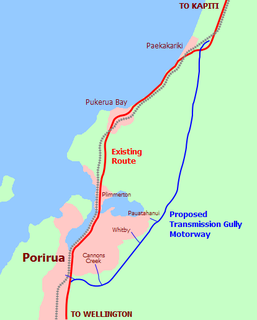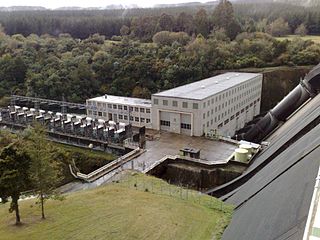New Zealand's electricity market (NZEM) is regulated by the Electricity Industry Participation Code administered by the Electricity Authority (EA). The Authority was established in November 2010 to replace the Electricity Commission.
The HVDC Inter-Island link is a 610 km (380 mi) long, 1200 MW bipolar high-voltage direct current (HVDC) transmission system connecting the electricity networks of the North Island and South Island of New Zealand together. It is commonly referred to as the Cook Strait cable in the media and in press releases, although the term is a complete misnomer. The link is much longer than its Cook Strait section, and it is not a single cable: the link actually consists of three operational HVDC power cables. The link is owned and operated by state-owned transmission company Transpower New Zealand.

Lake Karapiro is an artificial reservoir lake on the Waikato River, 30 kilometres (19 mi) south-east of the city of Hamilton in New Zealand's North Island. The lake was formed in 1947 by damming the Waikato River to store water for the 96-megawatt Karapiro hydroelectric power station.

Haywards is a small hillside suburb in the Hutt Valley near Wellington, New Zealand. It is notable for its large electrical substation, which is the main switching point for the Wellington region, and the home of the North Island converter station for the HVDC Inter-Island, which links the North and South Island electricity networks together.
Te Apiti is a wind farm owned and operated by Meridian Energy. It is located on 11.5 km² of land north of the Manawatu Gorge in the North Island of New Zealand. At 90.75 MW, it was New Zealand's largest capacity wind farm until September 2007, when the third stage of the nearby Tararua Wind Farm was completed.

Kordia is a New Zealand government-owned broadcast and telecommunications company, operating in Australia and New Zealand. It provides national communications services for broadcast and telecommunications customers in New Zealand, as well as specialised network systems. New Zealand customers include: Vodafone New Zealand, 2degrees, Sky Television, TVNZ, Mediaworks, Radio New Zealand, Spark New Zealand, Freeview, and The Radio Network. In Australia, Kordia provides contracting and consulting services for major telecommunications players, including Telstra, Optus, Vodafone and Hutchison.
Powerco is the second-largest gas and largest electricity distributor in New Zealand. It is one of only two companies to distribute both electricity and natural gas through their network. Its network delivers electricity and gas to households around the North Island from the national electricity transmission network Transpower and the natural gas transmission system owned and operated by Vector Limited.
The Electricity Corporation of New Zealand Ltd (ECNZ) is a New Zealand state-owned enterprise (SOE) formed on 1 April 1987, as a transition entity in the process of deregulating the New Zealand electricity market. Most of ECNZ's remaining liabilities were resolved in the late 2000s, and ECNZ is now a residual entity with the sole remaining task of winding up a series of land title issues.

The Transmission Gully Motorway is a 27 km four-lane motorway under construction in Wellington, New Zealand. Construction officially began on 8 September 2014 and completion is scheduled for 2020.
The electricity sector in New Zealand uses mainly renewable energy sources such as hydropower, geothermal power and increasingly wind energy. 82% of energy for electricity generation is from renewable sources, making New Zealand one of the lowest carbon dioxide emitting countries in terms of electricity generation. Electricity demand has grown by an average of 2.1% per year from 1974 to 2010 but decreased by 1.2% from 2010 to 2013.
The Rodney Power Station is a proposal for a natural gas fired combined cycle power station developed by Genesis Energy Limited.

Whakamaru Power Station is a hydroelectric power station on the Waikato River, in the North Island of New Zealand. It is the fourth hydroelectric power station on the Waikato River.

The National Grid is the nationwide system of electric power transmission in New Zealand. The national electricity transmission grid is owned, operated, and maintained by state-owned enterprise Transpower New Zealand, although some lines are owned by local distribution companies and leased to Transpower. In total, the national grid contains 11,803 kilometres (7,334 mi) of high-voltage lines and 178 substations.
HVDC BorWin1 is the first HVDC facility in the world to be built for importing power from an offshore wind park to shore, and the first to use voltage source converters (VSC) in Germany.
It connects the offshore wind park BARD Offshore 1 and other offshore wind farms in Germany near Borkum to the European power grid.
The facility was built by ABB and has a capacity of 400 MW at a bipolar voltage of ±150 kV.
HVDC BorWin1, which leads from BorWin Alpha Offshore Platform to Diele substation, consists of a 75 kilometres (47 mi) of underground and 125 kilometres (78 mi) of submarine cable.

The Whakamaru to Brownhill Road transmission line is a double-circuit 400 kV capable transmission line constructed by Transpower to increase the capacity of the National Grid between the southern Waikato and the city of Auckland. The line runs from the Whakamaru sub-station near the Whakamaru Power Station, over a distance of 186 kilometres (116 mi) to the new Brownhill Road substation near Whitford in southeastern Auckland. The line will initially be operated at 220 kV. From Brownhill Road, 220 kV underground cables connect the line to the Pakuranga sub-station in eastern Auckland. The project was the subject of considerable controversy and protest during the planning and approval stages. Construction of the line started in February 2010, and the line was commissioned on 30 October 2012. The transmission line forms the major part of a wider North Island Grid Upgrade project with a forecast cost to completion of $894 million.
The New Zealand Electricity Authority is an independent Crown entity responsible for the regulation of the New Zealand electricity market. The Authority was established in November 2010, following a government review of the electricity industry, and replaced the Electricity Commission. The Authority has a narrower focus on industry competition, reliability and efficiency than the Electricity Commission had.
MainPower New Zealand Limited is an electricity distribution company, based in Rangiora, New Zealand, responsible for electricity distribution to over 37,000 customers in the Canterbury Region north of the Waimakariri River. MainPower was formed in 1994, after the Energy Companies Act 1992 required the North Canterbury Electric Power Board to reform into a commercial power company. More reforms in 1998 required electricity companies nationally to split their lines and retail businesses, with MainPower retaining its lines business and selling its retail business to Contact Energy.
The North Auckland and Northland (NAaN) grid upgrade project reinforced transmission into the Auckland Region and across the harbour to North Auckland and the Northland Region. It added new 220 kV transmission capacity to the National Grid by providing 37 km of underground cable between the Pakuranga,
Penrose, and Albany substations.






